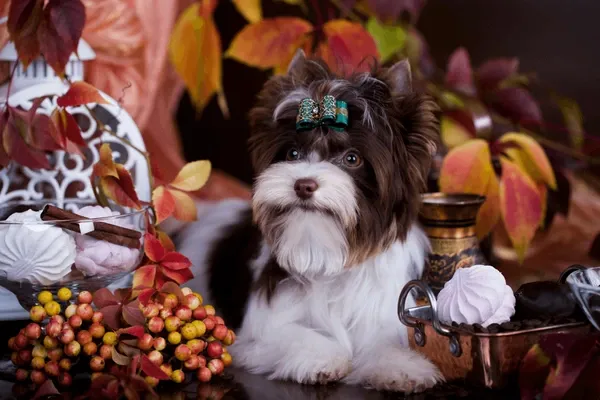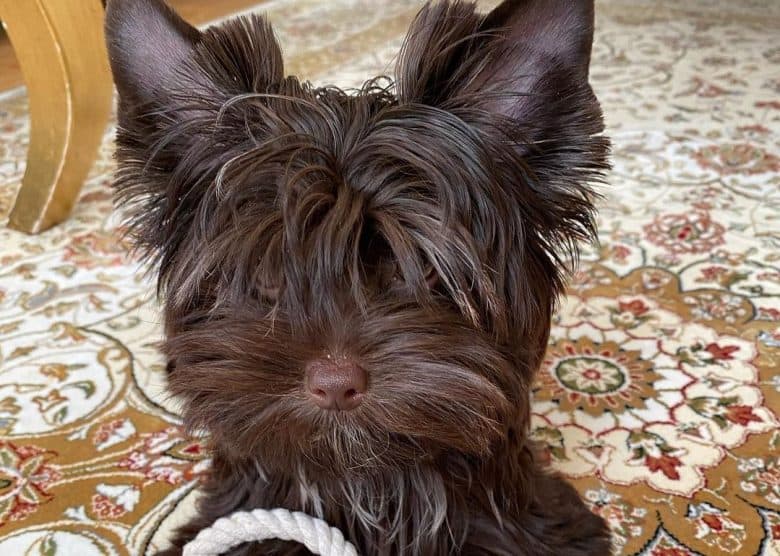Chocolate Yorkies are a unique variation of the Yorkshire Terrier breed that have become increasingly popular in recent years. These small dogs are known for their beautiful chocolate-colored coats and charming personalities. While they may look similar to traditional Yorkies, Chocolate Yorkies have some distinct characteristics that set them apart.

One of the most noticeable features of Chocolate Yorkies is their coat color. Unlike traditional Yorkies, which have a blue and tan coat, Chocolate Yorkies have a rich, chocolate-colored coat. This unique coloring is caused by a recessive gene that is passed down from both parents. While it may be difficult to find a Chocolate Yorkie puppy, many breeders specialize in this variation of the breed.
In addition to their distinctive coat, Chocolate Yorkies are known for their affectionate and playful personalities. They are loyal companions that love to be around their owners and are known for their high energy levels. Despite their small size, they are often fearless and make great watchdogs. With proper training and socialization, Chocolate Yorkies can make wonderful pets for families and individuals alike.
Understanding Chocolate Yorkies
Defining the Chocolate Yorkie
The Chocolate Yorkie is a variation of the traditional Yorkshire Terrier breed with a brown coat color. This color is caused by a recessive gene mutation that affects the production of melanin pigments in the hair. While the traditional Yorkie colors are black and tan, the Chocolate Yorkie has a brown coat that can range from light to dark shades.

The Genetics Behind the Color
The brown coat color of the Chocolate Yorkie is caused by a recessive gene mutation that affects the production of melanin pigments in the hair. Melanin is a pigment that gives color to hair, skin, and eyes. There are two types of melanin: eumelanin and phaeomelanin. Eumelanin produces black and brown colors, while phaeomelanin produces red and yellow colors.
The recessive mutation that causes the brown coat color in Chocolate Yorkies affects the production of eumelanin, resulting in a brown color instead of black. In order for a Yorkie to have a brown coat, it must inherit two copies of the recessive gene mutation from both parents. If a Yorkie inherits only one copy of the mutation, it will have a black and tan coat like the traditional Yorkie colors.
Chocolate Yorkie Vs. Traditional Yorkie Colors
The Chocolate Yorkie is often considered a rare and unique variation of the traditional Yorkie breed. While both Chocolate Yorkies and traditional Yorkies have the same physical characteristics and temperament, the main difference is in their coat color. The traditional Yorkie colors are black and tan, while the Chocolate Yorkie has a brown coat.
In terms of popularity, the traditional Yorkie colors are more common and widely recognized. However, the Chocolate Yorkie has gained a following among dog enthusiasts and breeders who appreciate its unique and distinctive appearance.
Overall, the Chocolate Yorkie is a fascinating variation of the traditional Yorkie breed that is sure to turn heads and capture hearts with its beautiful brown coat color.
Breed Information
Yorkshire Terrier Breed Overview
The Yorkshire Terrier, also known as the Yorkie, is a small dog breed that originated in Yorkshire, England in the 19th century. They were originally bred to catch rats in textile mills, but have since become popular as companion pets due to their small size and adorable appearance.
Yorkshire Terriers are known for their long, silky coats that come in a variety of colors, including the rare chocolate color. They are also known for their spunky and lively personalities, making them great pets for families and individuals alike.
Breed Standard and AKC Recognition
The American Kennel Club (AKC) recognizes the Yorkshire Terrier as a purebred dog breed. They have a breed standard that outlines the physical characteristics that a Yorkie should have, including their weight, height, and coat color.
According to the AKC breed standard, the Yorkshire Terrier should weigh no more than 7 pounds and stand no taller than 9 inches at the shoulder. Their coat should be long, silky, and glossy, and can come in a variety of colors, including blue and tan, black and tan, and chocolate and tan.
Popularity and Rarity of Chocolate Yorkies
While the traditional colors of the Yorkshire Terrier are blue and tan, black and tan, and gold and tan, the chocolate color is a rare and highly sought after variation. Chocolate Yorkies have a rich, dark brown coat that is highly prized by breeders and pet owners alike.
However, it is important to note that chocolate Yorkies are not recognized by the AKC breed standard, and are considered a non-standard color. This means that they may not be eligible to compete in AKC dog shows, and may be more difficult to find from reputable breeders.
Despite this, chocolate Yorkies remain a popular and beloved variation of the Yorkshire Terrier breed, and make wonderful pets for those who are lucky enough to find one.
Health and Care
Common Health Issues in Chocolate Yorkies
Like all dog breeds, chocolate Yorkies are prone to certain health issues. One of the most common health problems in this breed is dental issues. Chocolate Yorkies have small mouths, which can lead to overcrowding of teeth and an increased risk of tooth decay and gum disease. Regular dental check-ups and cleanings are essential to maintain good oral health.
Another health issue that can affect chocolate Yorkies is portosystemic shunt (PSS). This is a condition where the liver is unable to remove toxins from the blood, leading to a buildup of toxins in the body. Symptoms of PSS include vomiting, diarrhea, and lethargy. Treatment for PSS may involve surgery or medication, and pet insurance can be helpful in covering the cost of treatment.
Grooming and Maintenance
Proper grooming is essential for the health and well-being of chocolate Yorkies. Their long, silky coats require regular brushing and trimming to prevent matting and tangling. Bathing should be done as needed, but not too frequently as it can strip the coat of natural oils.
In addition to grooming, regular maintenance is also important. This includes trimming nails, cleaning ears, and checking for any lumps or bumps on the skin. Regular vet check-ups are also recommended to ensure overall health.
Diet and Nutrition

A healthy diet is crucial for the health of chocolate Yorkies. They require a balanced diet that includes high-quality protein, carbohydrates, and fats. It is important to avoid overfeeding, as chocolate Yorkies are prone to obesity. Treats should be given in moderation and as part of a balanced diet.
Vaccinations are also important to prevent common illnesses and diseases. Consult with a veterinarian to determine the appropriate vaccination schedule for your chocolate Yorkie.
Overall, proper health and care are essential for the well-being of chocolate Yorkies. Regular check-ups, proper grooming, and a balanced diet are key to keeping them healthy and happy.
Behavior and Training
Temperament and Personality
Chocolate Yorkies are known for their loving and friendly personalities. They are highly energetic and active, making them great companions for individuals who enjoy outdoor activities or who have a lot of energy to burn. However, they can also be quite stubborn and independent, which can make training a challenge. It is important to establish yourself as the pack leader early on in your relationship with your chocolate Yorkie to ensure that they respect your authority and listen to your commands.
Training Tips for Chocolate Yorkies
When it comes to training your chocolate Yorkie, it is important to be patient and consistent. Positive reinforcement techniques, such as treats and praise, work best with this breed. It is important to avoid punishment-based training methods, as these can cause your dog to become fearful and anxious.
One effective training technique for chocolate Yorkies is clicker training. This involves using a small clicker device to signal to your dog that they have done something correctly, followed by a treat or praise. This helps to reinforce positive behaviors and encourages your dog to repeat them in the future.
Another important aspect of training your chocolate Yorkie is socialization. This breed can be prone to separation anxiety and may become overly attached to their owners if they are not exposed to a variety of people and situations early on. It is important to expose your chocolate Yorkie to different people, animals, and environments from a young age to help them develop confidence and adaptability.
Overall, with patience, consistency, and positive reinforcement, chocolate Yorkies can be trained to be well-behaved and obedient companions.
Breeding and Puppies
Breeding Chocolate Yorkies
Breeding chocolate Yorkies requires careful consideration and planning. It is important to choose healthy and genetically sound parent dogs to ensure the health and well-being of the puppies. Breeders should also be knowledgeable about the breed's specific needs and characteristics to ensure successful breeding.
Finding Reputable Breeders
When searching for a reputable breeder, potential owners should do their research and ask for referrals from trusted sources. It is important to visit the breeder's facility and meet the parent dogs before committing to a purchase. Reputable breeders should also be willing to provide documentation of the parent dogs' health and genetic testing.
Cost and Considerations for Potential Owners
The cost of a chocolate Yorkie puppy can vary depending on the breeder and location, but potential owners should expect to pay a premium price for this rare color variation. In addition to the initial cost of the puppy, owners should also consider ongoing expenses such as food, grooming, and veterinary care.
Potential owners should also be aware of the breed's specific needs and temperament. Yorkies are known for their high energy and can be prone to separation anxiety. They also require regular grooming to maintain their signature silky coat.
Overall, breeding and owning chocolate Yorkies requires careful consideration and dedication. By working with reputable breeders and providing proper care, owners can enjoy the unique and charming personality of these beloved little dogs.

Physical Characteristics
Size and Body Structure
Chocolate Yorkies are a small breed of dog, typically weighing between 4 and 7 pounds and standing 6 to 7 inches tall at the shoulder. They have a compact, well-proportioned body with a short back and a level topline. Their legs are straight and muscular, and their feet are small and round.
Coat and Color Variations
The coat of a Chocolate Yorkie is silky, fine, and straight, with a glossy sheen. The color of their coat is a rich, dark chocolate, which is caused by a recessive gene that produces a brown coat instead of the traditional black and tan. The coat can also have some variations such as lighter shades of brown. They have a single layer coat that does not shed much, making them a great choice for people with allergies.
Distinctive Features
One of the most distinctive features of a Chocolate Yorkie is their ears. They are small, V-shaped, and carried erect. Their eyes are round, dark, and sparkling, and their nose is black. Their tail is docked to half its length and is carried slightly higher than the level of the back. Chocolate Yorkies have an overall elegant and refined appearance, with a charming and endearing expression.
In summary, Chocolate Yorkies are a unique and distinctive breed with a rich, dark chocolate coat. They have a small, well-proportioned body with straight legs and small feet. Their ears are small and erect, and their eyes are round and dark. Their tail is docked and carried slightly higher than the level of the back. Their coat is silky, fine, and straight, and they have an overall elegant and refined appearance.
History and Origin
The Origin of Yorkshire Terriers
Yorkshire Terriers, also known as Yorkies, are a small breed of dog that originated in the county of Yorkshire, England in the 19th century. It is believed that the breed was developed by crossing various terrier breeds, including the Skye Terrier, Dandie Dinmont Terrier, and Manchester Terrier. Yorkies were originally bred for hunting rats and other vermin in textile mills and mines.
Evolution of the Chocolate Color in Yorkies
The chocolate Yorkshire Terrier is a relatively new color variation of the breed. The genetic makeup of the chocolate Yorkie is the same as that of traditional Yorkies, with the only difference being the presence of the TYRP1 gene, which causes a brown coat color. The chocolate color was first introduced to the breed in the 1980s, and since then, it has become increasingly popular among breeders and pet owners.
The history of the chocolate Yorkie can be traced back to a single dog named "Sassy," who was born in 1984. Sassy was the result of a breeding between two traditional Yorkies, but she had a unique brown coat color. Her breeder recognized the potential of the color variation and began selectively breeding for the chocolate color.
Today, chocolate Yorkies are recognized by some kennel clubs, including the American Kennel Club, but they are still considered a rare color variation. Breeders must carefully select their breeding pairs to ensure that the TYRP1 gene is not overrepresented in the gene pool, which can lead to health problems. Despite their rarity, chocolate Yorkies are beloved by many for their unique and beautiful coloration.
Ownership Experience
Living with a Chocolate Yorkie
Owning a Chocolate Yorkie can be a rewarding experience for those who enjoy the company of small dogs. These lap dogs are known for their affectionate and loyal nature, making them great companions for individuals and families alike. They are also known for their playful and energetic personalities, which can bring a lot of joy and entertainment to their owners.
One thing to keep in mind when owning a Chocolate Yorkie is their small size. They are considered a small breed, typically weighing between 4 and 7 pounds. This means they may not be the best fit for households with young children or larger pets, as they can be easily injured. However, they do well in apartments and smaller living spaces, making them a great choice for those who live in urban areas.
Another aspect to consider when owning a Chocolate Yorkie is their growth chart and lifespan. These dogs typically reach their full size by the age of 1 year and have a lifespan of around 12-15 years. It is important to provide them with proper nutrition and exercise to ensure they live a healthy and happy life.
Community and Social Aspects
Owning a Chocolate Yorkie can also come with a sense of community and socialization. Many owners of small dogs enjoy meeting up with other owners and their pets for playdates and social events. This can be a great way to bond with other pet owners and provide socialization for your dog.
In addition, there are many online communities and resources for owners of Chocolate Yorkies and other small dogs. These communities can provide valuable information on training, health, and other aspects of pet ownership. They can also offer support and advice for owners who may be experiencing challenges with their pets.
Overall, owning a Chocolate Yorkie can be a rewarding and fulfilling experience for those who are prepared for the responsibilities of pet ownership. With proper care and attention, these dogs can bring a lot of joy and companionship to their owners.

Conclusion
In conclusion, the Chocolate Yorkie is not just a pet; it's a delightful companion that adds sweetness to your life. From their unique coat color to their charming personality, these pint-sized canines are a joy to have around. By understanding their specific needs and providing the care they deserve, you can enjoy years of love and companionship with your chocolate-coated friend.
Frequently Asked Questions (FAQs)
- Q1: Are Chocolate Yorkies hypoallergenic?
- While no dog breed is entirely hypoallergenic, Chocolate Yorkies are known to produce fewer allergens than some other breeds.
- Q2: What is the average lifespan of a Chocolate Yorkie?
- On average, Chocolate Yorkies live between 12 to 15 years, provided they receive proper care and attention.
- Q3: Do they require special grooming due to their coat color?
- Yes, the chocolate coat of these Yorkies requires regular grooming to maintain its shine and prevent matting.
- Q4: Can Chocolate Yorkies live in apartments?
- Yes, their small size makes Chocolate Yorkies well-suited for apartment living, as long as they receive enough exercise.
- Q5: Are they good with children?
- Chocolate Yorkies are generally good with children, but proper socialization and supervision are essential to ensure a harmonious relationship.




